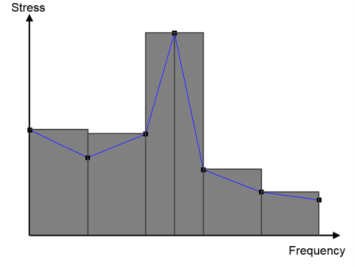In the Vibration Fatigue evaluation, only deterministic vibration can be simulated; random vibration analysis is outside its scope.
Since the S-N curve is heavily influenced by the R-value, R, which in turn depends on the mean stress and the stress amplitude, the stress state from both load mechanisms must be considered.
where p is the number of excitation frequency, while the argument
t is the time. The time dependence is in this case harmonic.
In the presence of static loads, for example self-weight, a Prestressed Analysis, Frequency Domain study computes both the mean stress state,
Σm, and the amplitude stress state,
Σa, for each excitation frequency. The stress state at a given excitation frequency is given by
The mean stress is computed from the stress state caused by the static loads. Since these loads are constant at all excitation frequencies, the resulting stress state, Σm, is also constant and so is the mean stress,
σm. When the option
Directional stress is used, the mean value is taken as the normal stress on the plane defined by the
Direction vector. For example, if the stress in the
x direction is examined then
σm = σxx.
In case of Signed von Mises, the mean stress is computed using the von Mises equivalent stress from the static load case.
where i is the imaginary unit. The modulus of a complex stress,
rkl, is the amplitude stress for the stress tensor component, while the argument of the complex number,
θkl, is the phase shift of a stress component. These variables are computed using
Thus, the stress component varies between rkl and
-rkl during one cycle and the stress history is defined by
where ω is the angular frequency that is related to the excitation frequency through
ω = 2πf.
The Directional stress option considers a stress normal to a given plane. If, for example, the
yz-plane is considered, the normal stress is given by
The Signed von Mises option computes an equivalent stress which depends on all components of the complex stress tensor. The square of the von Mises stress is given by
Both the squares of the individual stress components, Equation 3-7, and the cross products between the two normal stress components,
Equation 3-8, can be written on the general form
The S-N curve provides the stress amplitude as a function of the R-value and the number of cycles to failure, N. Since both the fatigue mean stress and the fatigue stress amplitude are known for each excitation frequency, the R-value is computed by
where the subscript p denotes the frequency dependence. Once the stress amplitude and R-value are known for each excitation frequency,
fp, the limiting number of cycles at each excitation frequency,
Np, is extracted from the S-N curve. The relation between the duration time of the excitation at a given frequency,
tp, and the number of cycles experienced is given by
The partial damage from a given excitation frequency is simply the ratio ni/
Ni. Following the Palmgren-Miner linear damage rule the damage from all excitation frequencies is summarized using
where q denotes the number of excitation frequencies. The fatigue usage factor
fus denotes the cumulative damage. Values below 1 means that fatigue is not expected during the analyzed frequency sweep.
The number of frequency blocks depends on the number of frequencies, F, specified in the
Frequency Domain study, where the stress response is computed at each frequency. A frequency block stretches between two evaluation frequencies and the stress response at the evaluation frequency that gives a higher stress value is used in the computation of the damage. As an example, in the figure below the stress response is computed at 7 frequencies in the
Frequency Domain study. This gives 6 evaluation blocks. Note that blocks do not need to stretch over equal frequency intervals. If a computation is made around an eigenfrequency the stress response at this evaluation frequency will be used in fatigue computation for the both neighboring blocks of the evaluation frequency. The use of the higher stress for the entire block gives a conservative estimate. Due to the nonlinear dependence between stress and fatigue life, the larger stress cycles will dominate the fatigue life prediction.

where tb is the time duration of a block,
fp+1 is the higher evaluation frequency, and
fp is the lower evaluation frequency. The number of cycles in each block,
nb, is evaluated using
Note that the subscript b is the block number while
p is the frequency excitation number. The relation between these two is
b = p − 1.

